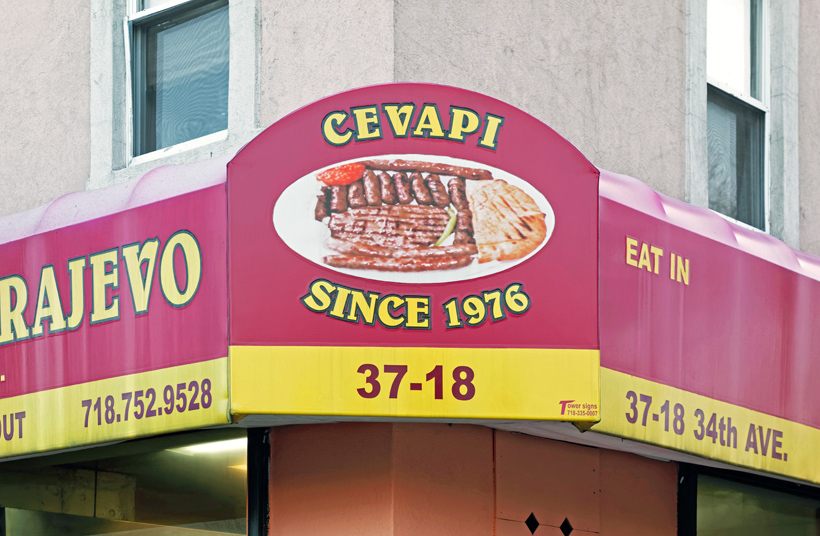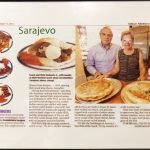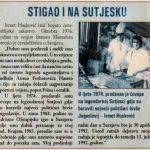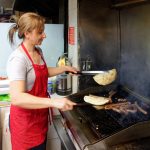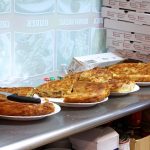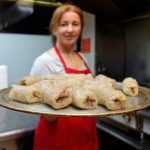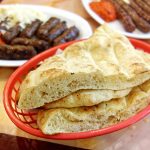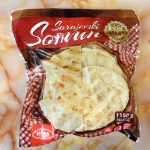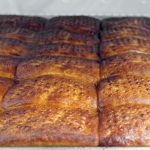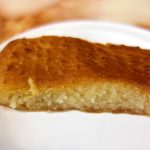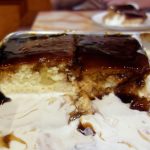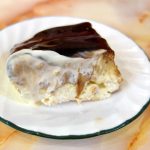A note about my restaurant reviews: New York City counts many Eastern European restaurants scattered across the five boroughs, most of them ignored by restaurant critics and diners alike. I intend to visit as many as I can and report!
If you want to eat simple, authentic Bosnian food in New York, Astoria is the place to go. Although this Queens neighborhood is better known for its Greek eateries, it also counts a handful of holes-in-the-wall that serve bureks and grilled meats, courtesy of the Bosnian immigrants who arrived in the 1990s. One such place is Ćevabdžinica Sarajevo. “Since 1976”, says the awning, but that’s rather misleading because in the beginning, owner Ismet Husković was running his ćevabdžinica (literally, a ćevapi house) not in Astoria, but Sarajevo. And, believe it or not, he was a bit of a ćevapi legend back then.
Apparently, Ismet learned his craft from another legend, albeit a soccer one: Asim Ferhatović, Sarajevo’s most famous player, who also happened to enjoy cooking ćevapi. Later, in 1974, Ismet was selling his little sausages in Sutjeska National Park, where most of Yugoslavia’s political bigwigs were vacationing — he claims to have served some to Marshal Tito himself. When he opened his place in Sarajevo in 1976, he was one of the top ten ćevapi masters in town, and he even won awards for his work during the 1984 Olympic games. Husković continued to prosper until the war started, bringing business to an abrupt end: in July 1992, the building burned to the ground. He then moved to New York with his wife in 1994, and opened another ćevabdžinica shortly after.
While I don’t know what the original ćevabdžinica looked like, the decor at its New York reincarnation is pretty minimal. Imagine a pizza parlor, then add a screen broadcasting Bosnian TV above a panoramic photograph of Sarajevo, a few small alcoves with vaguely oriental tiles and lanterns, and the inevitable framed newspaper clippings of all the people who’ve reviewed the restaurant before me, plus a picture of FK Sarajevo circa 1985.
The menu, on the other hand, offers more options than I first expected (though not without a few hiccups, as we’ll see later). The grilled dishes represent a good third of the list, from the famous ćevapi or pljeskavica to kebabs, to chops. There’s no pork, of course, but you’ll find dishes made from chicken, veal, beef, and lamb. If you can’t make up your mind, the mixed meat platter brings you the classics plus a hefty selection of offal (kidneys, liver, and sweetbreads). Then there are the bureks (with meat, cheese, or spinach) and the “traditional hot dishes” (beef goulash, pasulj, stuffed pepper, and stuffed cabbage). Short soup and seafood sections drift away from Bosnian cooking towards American standards (salmon, chicken noodle soup), while salads remain somewhat Balkanic (shopska, Greek). Finally, save some room for dessert — there’s a whole refrigerator of traditional options.

I even managed to invite myself into the kitchen! These days, it seems like the ćevapi are no longer prepared by the master himself, although he still works the shop and keeps an eye on things. I’m gonna go with a hunch and assume that the woman at the stove is his daughter (today’s reporters don’t always need to verify the truth to write their story).
Let’s start with a few slices of burek. The cheese burek is quite nice, with the right cheese-to-dough ratio, and a good number of layers. The cheese itself isn’t insanely flavorful, but it’s pleasantly salty. My main complaint is that it’s a little bit soft because it’s been reheated (most likely in the microwave we hear beeping regularly in the kitchen), and it would be better fresh out of the oven. It may not be as satisfying as the one from Dukagjini Burek, but I would have it again.
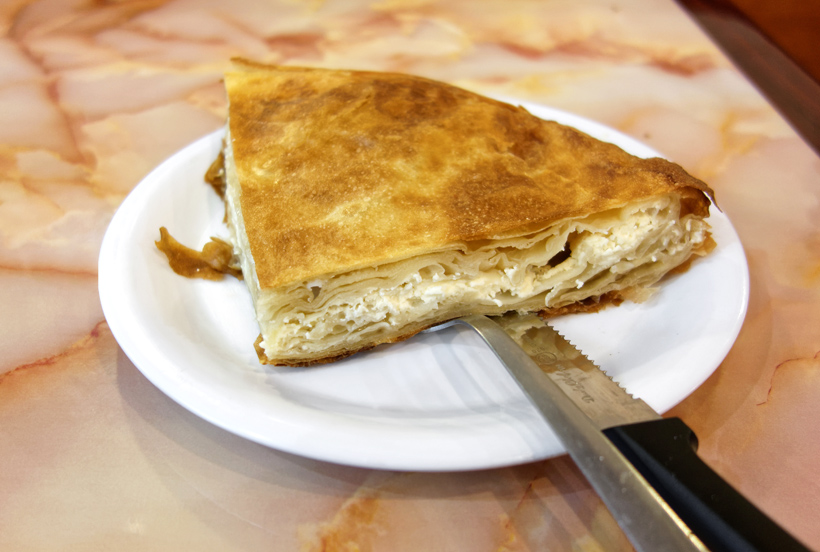
The same goes for the meat burek. Maybe this one had just been made fresh, because the dough was a lot crispier outside. The filling is fairly minimalist: greasy (in a good way) ground beef seasoned with just salt and pepper, no onion. I’d like a little more meat, because that’s a lot of dough altogether.
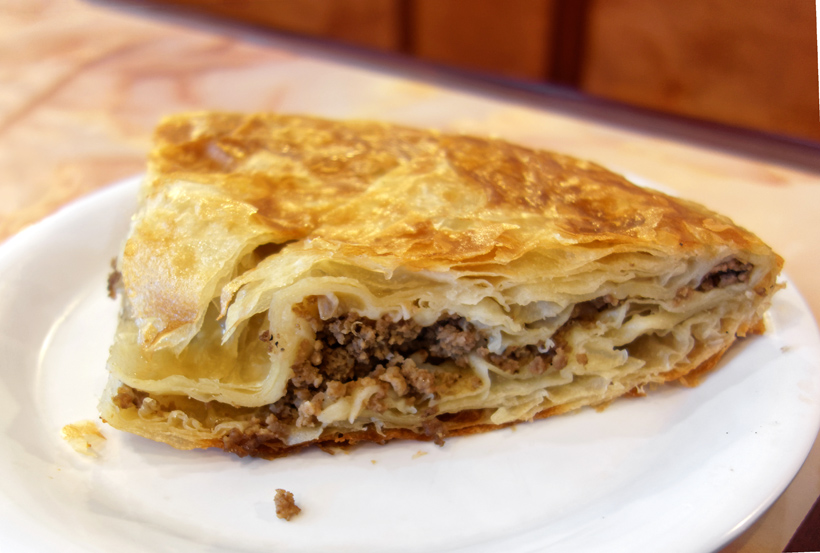
But just as you wouldn’t judge barbecue pit masters by their pizzas, you can’t judge Sarajevo’s ćevapi master by his bureks. Time to fire that grill!
Ismet’s ćevapi don’t disappoint. They’re beef only, tender and juicy, well seasoned with salt and pepper. They might actually be spicier than I first think because they make me pretty thirsty. They don’t have any of the bouncy texture that you encounter in some places (see my explanations here). You get ten per portion, and they come with some coarsely chopped raw onions that I don’t really care for, ajvar, and somun (a cousin of lepinja). The ajvar tastes a lot like red pepper and may or may not be homemade. I assume that if you ask, you can get the ćevapi as a sandwich (in the flatbread, with kajmak and ajvar), but this isn’t how they come by default.
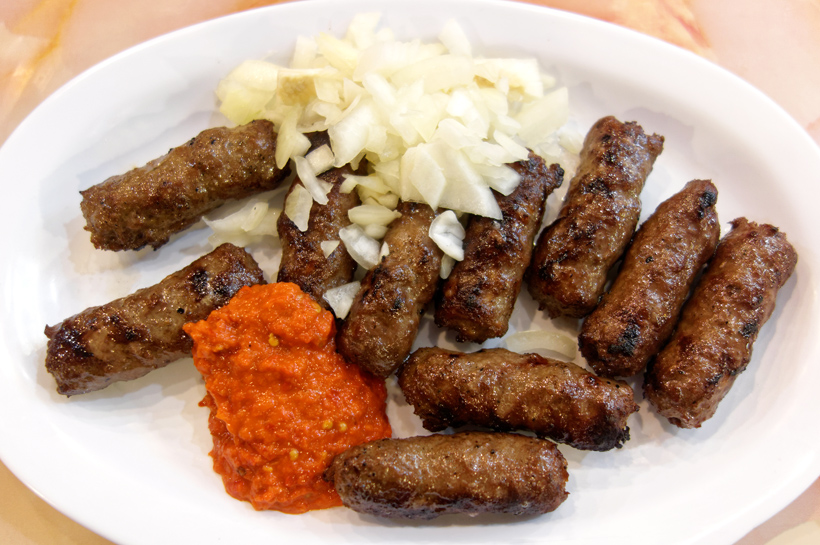
The pljeskavica seems to use the same mixture as the ćevapi, and all the garnishes are identical too (ajvar, onion, somun). I don’t know if it’s by design or out of hurry, but the giant patty arrived cooked rare inside. I certainly don’t mind, especially since the meat is plenty moist and charred outside.
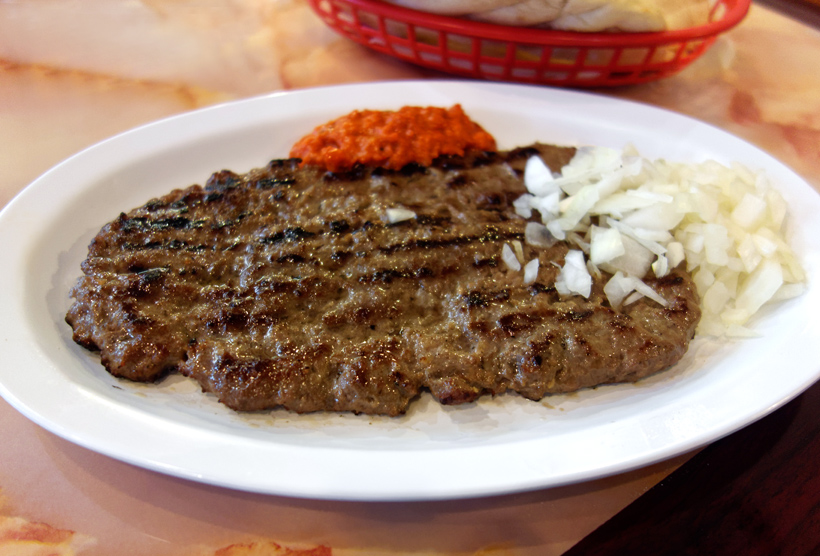
The bosanske sudžukice are another kind of little beef sausages, but thinner and longer, shaped roughly like frankfurters. Again, the meat mixture is about the same, and it’s hard to tell whether the differences I’m detecting (the meat feels slightly more compact, saltier and fattier) are intentional or just the result of the way it’s shaped or the product of different batches of the same recipe. Same garnishes.
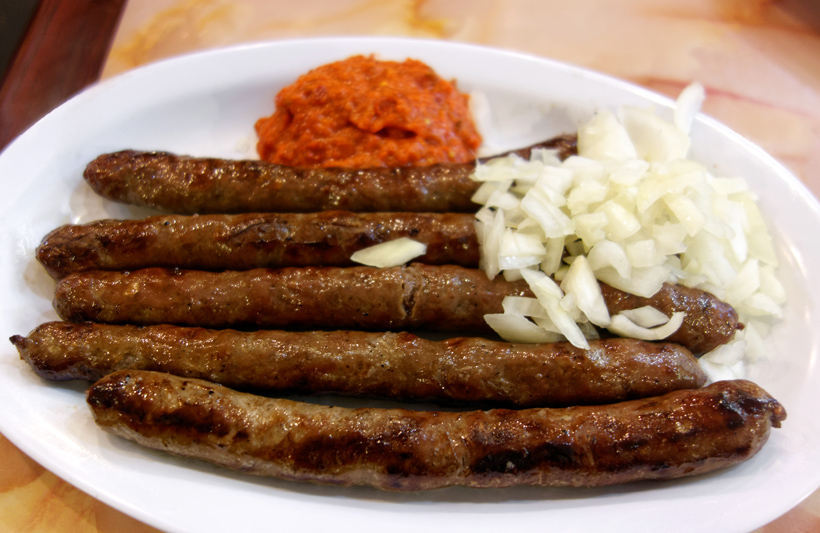
Instead of getting the ćevapi plus the pljeskavica plus the sudžukice, it certainly makes more sense to order some of the kebabs or chops. Yet, I didn’t do that, and I think there are a couple reasons why this happened. First, the restaurant features a large menu board with pictures (like in a Chinese restaurant), but it doesn’t include all the dishes. It’s up to you to grab one of the delivery menus at the counter if you want the full list. It helps to know that such delivery menus exist, since nobody really tells us about them. Then, some of the dishes weren’t available at the time of my visits, and I can’t tell you if that was temporary or if they’ve been silently retired. That grilled trout and those lamb chops you saw on one or more of the three different menus (outside board, inside board, delivery paper) may be gone forever.
Let’s talk about the somun a little bit more. For the past six years, the owner has been getting them straight from Sarajevo every Tuesday. “Different oven, different flour, different water”, he claims. True to a [very, very small] degree, but packaged industrial bread, even from Sarajevo, is no match for fresh bread. It’s reasonably good, though the kitchen tends to reheat it a bit hastily: one time it was still soft and chewy, barely warm, and the next it was soaked in grease from the grill.
If neither grilled meat nor bureks are your thing (what the hell are you doing in a Bosnian restaurant?), there are a few more hearty dishes. The pëasulj, like it’s Kosovan cousin groshë, is a very thick bean soup with a little bit of meat. This soup must be cooked for quite a long time, and I assume some of it was blended, because most of those beans are reduced to a mush. There are a lot of vegetables in there too; I spot celery, onion, red pepper, and carrot. You don’t really taste the meat, because it’s cut into small cubes and cooked for so long, but that’s the way pasulj is made — didn’t you have enough meat with your ten ćevapi? Very good and very flavorful, though I could do without the dried herbs sprinkled on top, as I couldn’t even tell you what they are. The bowl comes with a big loaf of white bread that’s neither bad nor amazing. Like most of the other dishes, this is a generous portion: even if you don’t eat anything else, you won’t leave hungry!
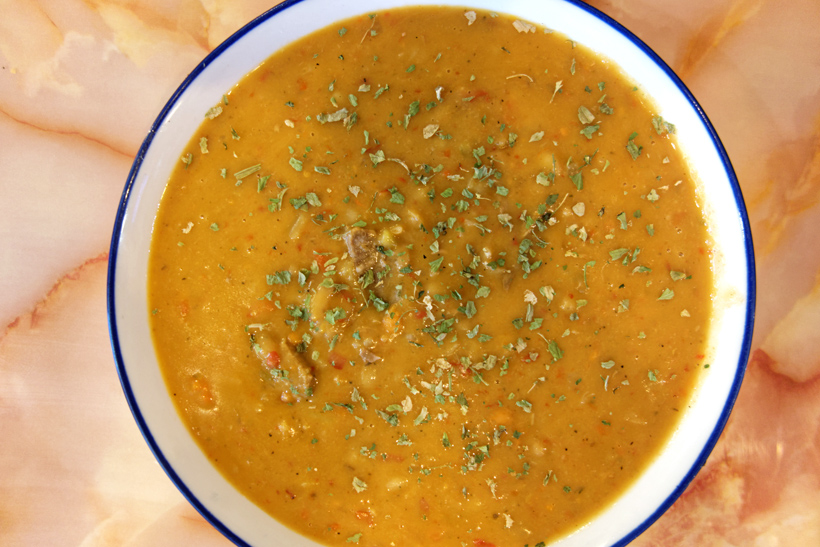
The sarma consists of stuffed cabbage rolls with a red pepper sauce and potato purée. It’s always a simple dish, but here it’s well done. The rolls are filled with very cooked rice, carrot, red pepper, and a little bit of meat (lean, ground beef, I think). Like the bean soup, the sarma tastes a lot like vegetables and not really like meat, which is appreciable in this context. The cabbage is well cooked but not overcooked like in those East Village Ukrainian restaurants I keep bitching about (I guess I’ll have to review some of them sooner or later). The sauce, red peppers and cream, goes well. The potato purée is more problematic… First it arrived stone cold, so it had to take a trip back to the microwave. Once hot, it was super dense, like concrete. It’s probably homemade — it actually tastes like potato — but most likely with floury Idaho potatoes, the kind you shouldn’t use to make purée. And it’s finished with the same insipid dried herbs on top. I’d recommend asking for a different side, if possible.
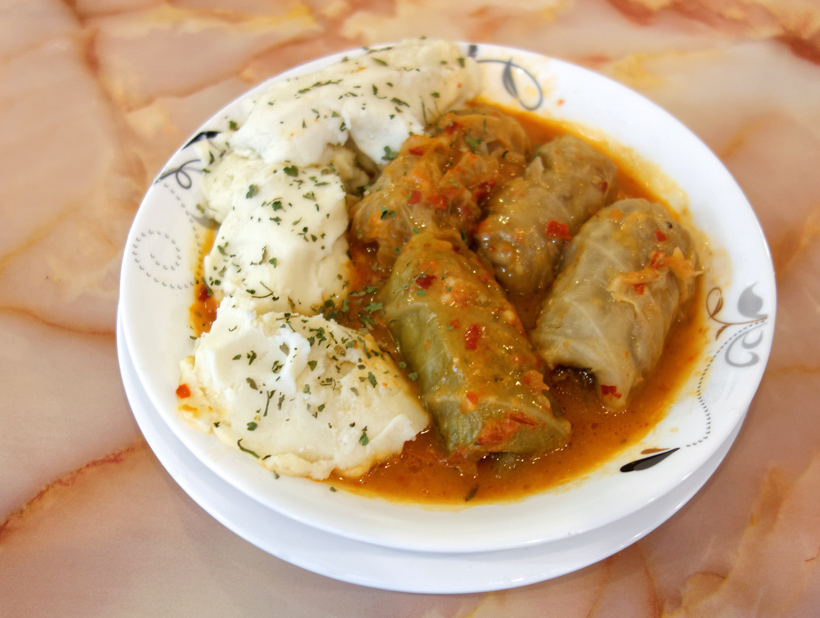
Finally, Ćevabdžinica Sarajevo is probably the place in New York with the widest selection of Bosnian desserts. Remember those other Balkan restaurants where the only option on the menu is baklava and they can’t be even bothered to make it half of the time? Well, here you have NINE different sweet dishes, all homemade as far as I can tell, most of which you’ve never heard of before!
The hurmasica is a thin buttery cake drenched in sugar syrup. It’s super simple, but everybody likes cake and sugar, so it’s hard not to like this dessert. And despite the syrup, it’s not crazy sweet either.
The tufahija is an apple cooked in syrup and filled with walnuts. What can I say… It’s a good cooked apple. I like it better than a raw apple, the walnuts are nice… But it’s not terribly exciting. It comes topped with mediocre commercial whipped cream and chocolate syrup, which doesn’t help.
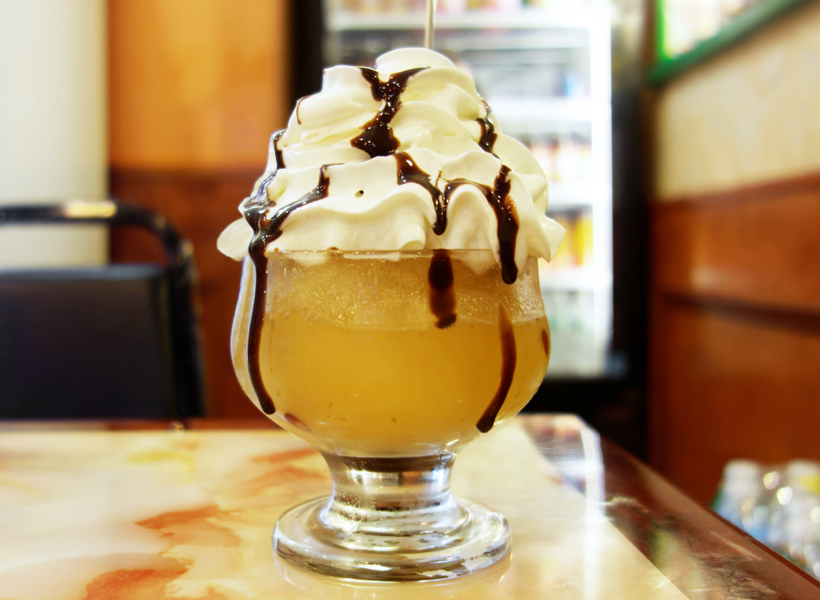
Then there’s the trileće, a Balkan variation on the tres leches cake. Supposedly, it owes its unexpected addition to the Bosnian culinary repertoire to the popularity of Brazilian soap operas in the Balkans, which led local chefs to reverse-engineer the dessert! Like the original, the trileće consists of a light sponge cake soaked in a mixture of cream and milk, but then it’s finished with a layer of caramel on top. This is the best dessert I’ve tried at Ćevabdžinica.
And now their worst dessert, the kadaif: shredded filo dough, cooked (fried?) and soaked in simple syrup (Bosnians sure love their simple syrup). It looks like a plate of Chewbacca’s hair. It probably tastes better than Chewie’s hair, but the flavors are really basic and boring.
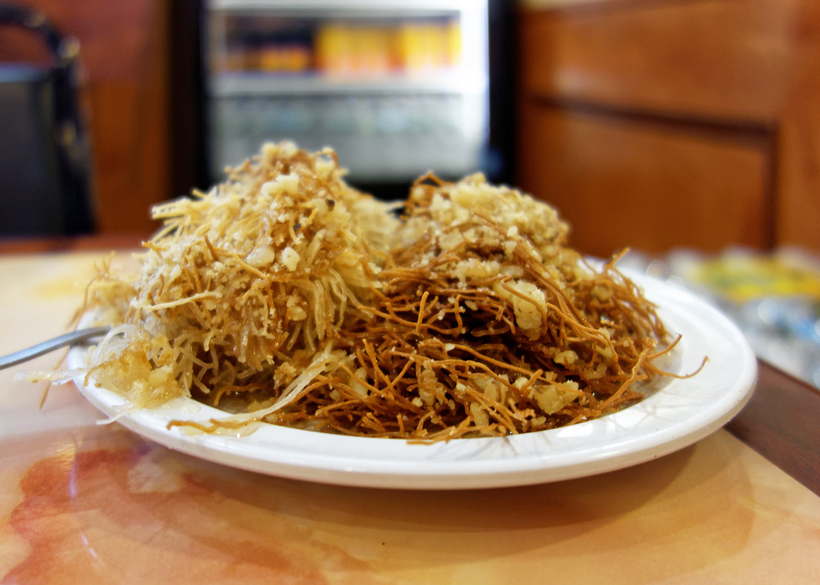
The owner insisted on offering us Bosnian coffee, which is essentially the same as Turkish coffee. Even the sugar comes from Bosnia (from Jelah if you must know — Husković had me decipher the packaging until we found the origin). Because sugar, like water, flour, and ovens, is different in Bosnia. I usually don’t drink coffee so don’t take my word for it, but I thought it was quite good, nice and strong. As for the sugar cube, we’re told you’re supposed to dip it into the coffee and suck it. Then close your eyes and think of Sarajevo.
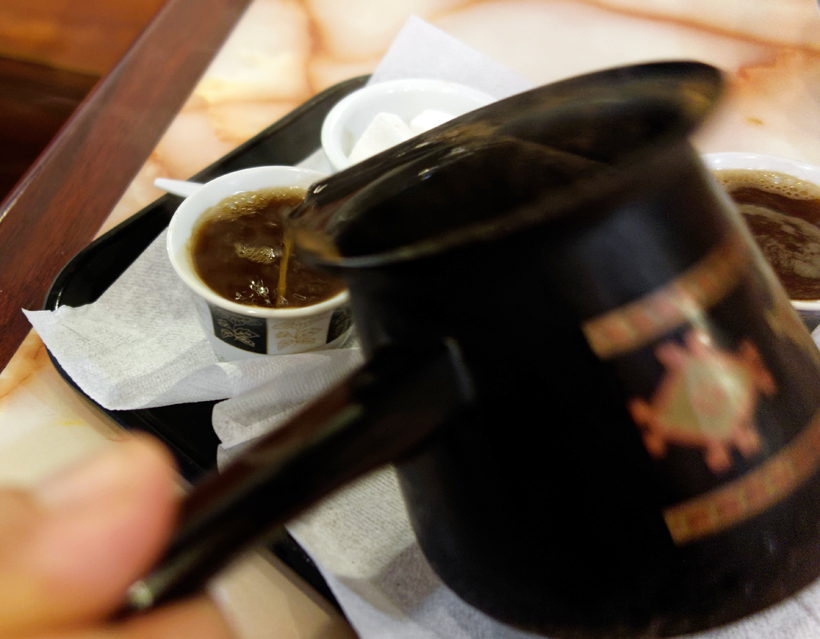
Ćevabdžinica Sarajevo doesn’t serve alcohol, but you can bring you own. The cheese burek goes very well with any Eastern hard liquor of your choice. You might as well bring your own soft drinks too, because options are limited — unless you choose to try the infamous Cockta (like Coke with an herbal twist) or the orange Jupi (similar to Fanta but made in Slovenia). Don’t look for diet beverages; most Eastern Europeans still think that sweet drinks without sugar are an oxymoron that only Americans are stupid enough to believe in.
Service, like the decor, is minimal: you order your food at the counter and the owner or cook brings it to you as soon as it’s ready, typically only a few minutes later. The place is more akin to a fast food parlor than a sit-down restaurant. Some people on Yelp complain that the staff is rude, but I think that’s a misunderstanding — I’d say they’re terse but can be nice if you give them a chance.
It’s good to be able to eat bureks, ćevapi, pasulj and Bosnian desserts in one place for a change. And it’s good to be able to eat bureks without having to visit the Bronx Zoo afterwards. True, some dishes are more successful than others: the grilled meats fare better than the bureks, and some of traditional Bosnian desserts can be simple and boring. Still, overall, the food at Ćevabdžinica Sarajevo is worth a try. I just have three simple suggestions to make the place even better: 1. Display one single consistent menu throughout the restaurant. 2. Throw away the microwave. 3. Get a license to serve wine and beer, and preferably stock those from the motherland (different grapes, different grain, different yeast). Seriously, can you picture Marshal Tito with a bottle of Poland Spring?
Cuisine: Bosnian
Picks: ćevapi, pljeskavica, pasulj, trileće
Avoid: potato purée, kadaif
Food: 7.5/10
